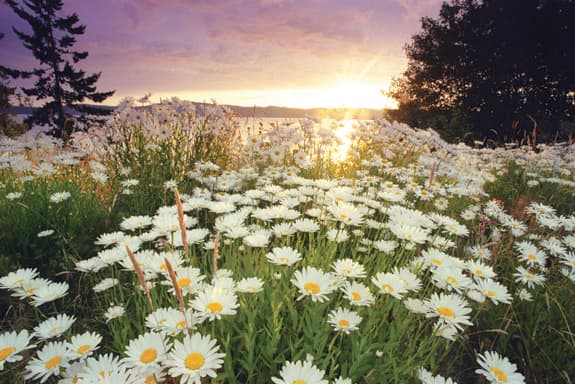Spring landscape photography: Create striking foreground interest

Foreground interest can create drama and a real sense of depth. In fact, one of the oldest tricks in the landscape book is to shoot with a wideangle lens and include subject matter in the immediate foreground.
The basic characteristic of the wideangle lens is its inherently greater depth of field, which also has a greater effect of drawing the viewer into the picture than other.
Try to capture a subject which either creates a striking contrast with the background or subtly complements the scene while creating interest.
Spring landscape photography: Wait for the light

On fresh spring days when the breeze moves clouds quickly, be patient and wait for the light to do what you want it to.
Patience is the golden rule in landscape photography – it simply cannot be rushed. How many times have you seen dramatic lighting and then run around in a mad rush to get the right shot from the right position?
Success actually works the other way – we need to find the right location and then wait for the amazing light to gush through the clouds. Take this approach and you’ll find yourself with more keepers than ever before.
Spring landscape photography: Focus on fog

Fog or mist is an excellent landscape photography weather condition.
They often occur in spring due to the contrast between night and daytime temperatures, with the cool night air causing warm, moist air in valleys to condense. In woodland, fog acts as a massive diffuser making distant trees fade into the background to create an atmosphere of mystery.
The brightness of fog or mist can fool an exposure meter so take your initial readings from the midtone, then take the shot and check your histogram. These conditions will inevitably dictate slow shutter speeds, especially if the lens is stopped down, so use a tripod, cable release and mirror lock-up.
Spring landscape photography: Shoot in low evening light

By late March the sun climbs quickly in the mornings to be far too high and harsh around the middle of the day for shooting landscapes.
Use this time wisely to do your legwork and check out potential shooting locations. This approach will help you find images without wasting good light, so that you can return later in the day when the sun is raking across the landscape almost horizontally.
Spring landscape photography: Avoid areas of white light

Overcast days are ideal for photographing woodland scenes in spring. But it is important to keep a watchful eye for small glimpses of sky that manifest themselves as white light.
If you don’t get your crop right you can find that white light creeps into the top of the frame and will ultimately distract from the overall image. If you crop in tight and eliminate all sky, interest can be focused solely on the forest scene.
Spring landscape photography: Use converging verticals for impact

When you point a wideangle lens upwards it will distort vertical shapes and lines – the result of which is often referred to in photographic terms as converging verticals.
In spring, take advantage of this phenomenon by swinging your wide lens ninety degrees upwards to take in the forest canopy. The tree tops will converge together from all corners to create a great impression with plenty of impact.
At this time of year the foliage is only just breaking and so the leaves will be that fresh, pale green of spring. On a clear day, these renewed green leaves will contrast nicely with the blue of the sky.
Spring landscape photography: Make good use of spring wild flowers

It’s one of those images that is synonymous with spring – a leafy woodland with pale-green leaves sprouting overhead, with the real feature being the bed of spring flowers underfoot.
Be it bluebells, daisies or dandelions, spring sees the sprouting of some of the most striking wildflowers in the country.
Head down to your nearest woodland or field, and either use your macro lens for close-up or your wideangle and feature them as foreground interest.
by Colin Varndell






